Information Technology Ethics: Three Distinct Perspectives of Applied Ethics
VerifiedAdded on 2023/06/08
|10
|1974
|209
AI Summary
This report evaluates the recent ethical dilemma faced by Uber and its ‘driverless car technology’ by evaluating different news articles and relevant literature. It discusses the incident based on three distinct perspectives of applied ethics including professional, philosophical and sociological. The report also provides alternative solutions to the issue and selects the best solution.
Contribute Materials
Your contribution can guide someone’s learning journey. Share your
documents today.

Information Technology Ethics
Three Distinct Perspectives of Applied Ethics
Three Distinct Perspectives of Applied Ethics
Secure Best Marks with AI Grader
Need help grading? Try our AI Grader for instant feedback on your assignments.
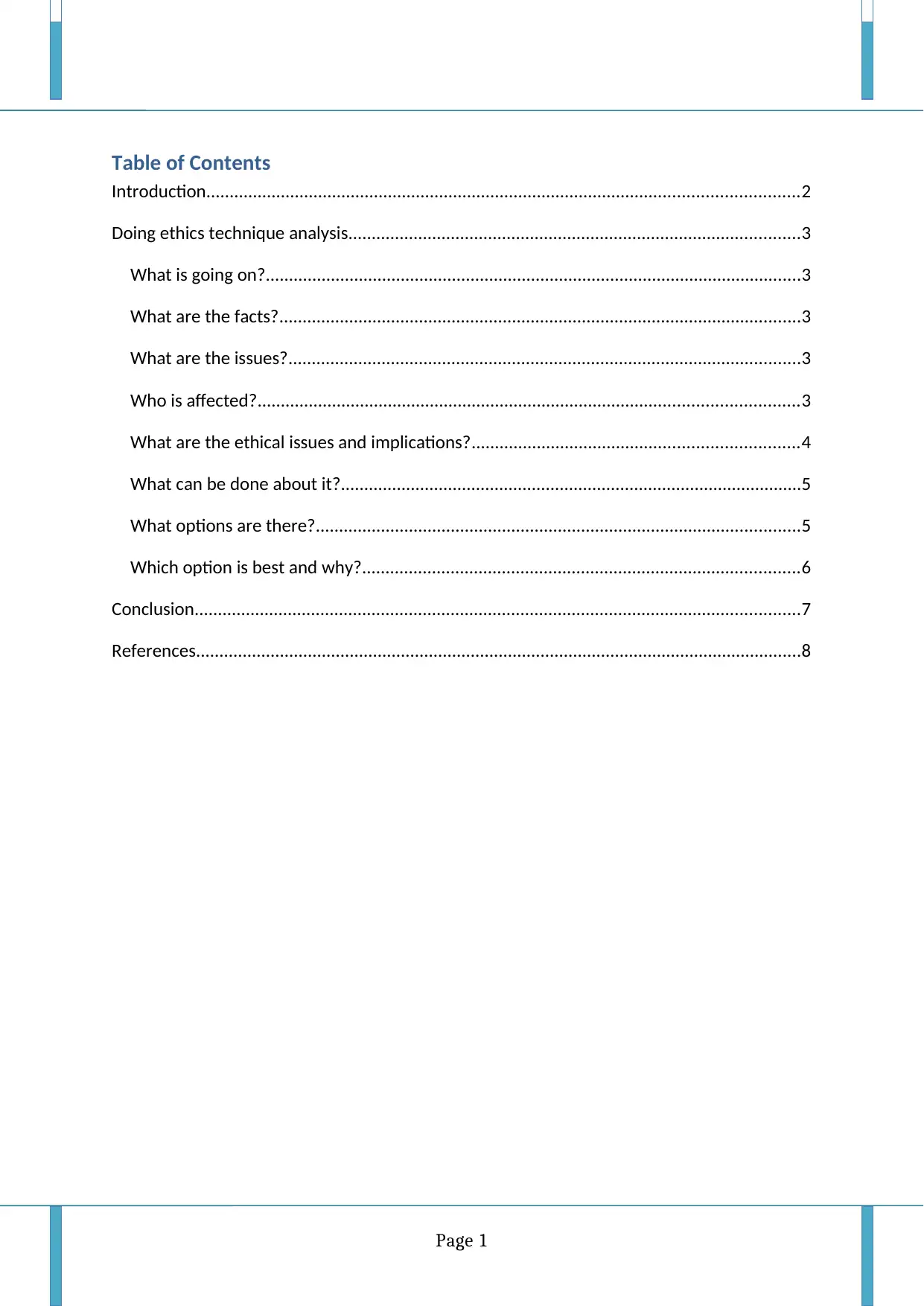
Table of Contents
Introduction...............................................................................................................................2
Doing ethics technique analysis.................................................................................................3
What is going on?...................................................................................................................3
What are the facts?................................................................................................................3
What are the issues?..............................................................................................................3
Who is affected?....................................................................................................................3
What are the ethical issues and implications?......................................................................4
What can be done about it?...................................................................................................5
What options are there?........................................................................................................5
Which option is best and why?..............................................................................................6
Conclusion..................................................................................................................................7
References..................................................................................................................................8
Page 1
Introduction...............................................................................................................................2
Doing ethics technique analysis.................................................................................................3
What is going on?...................................................................................................................3
What are the facts?................................................................................................................3
What are the issues?..............................................................................................................3
Who is affected?....................................................................................................................3
What are the ethical issues and implications?......................................................................4
What can be done about it?...................................................................................................5
What options are there?........................................................................................................5
Which option is best and why?..............................................................................................6
Conclusion..................................................................................................................................7
References..................................................................................................................................8
Page 1
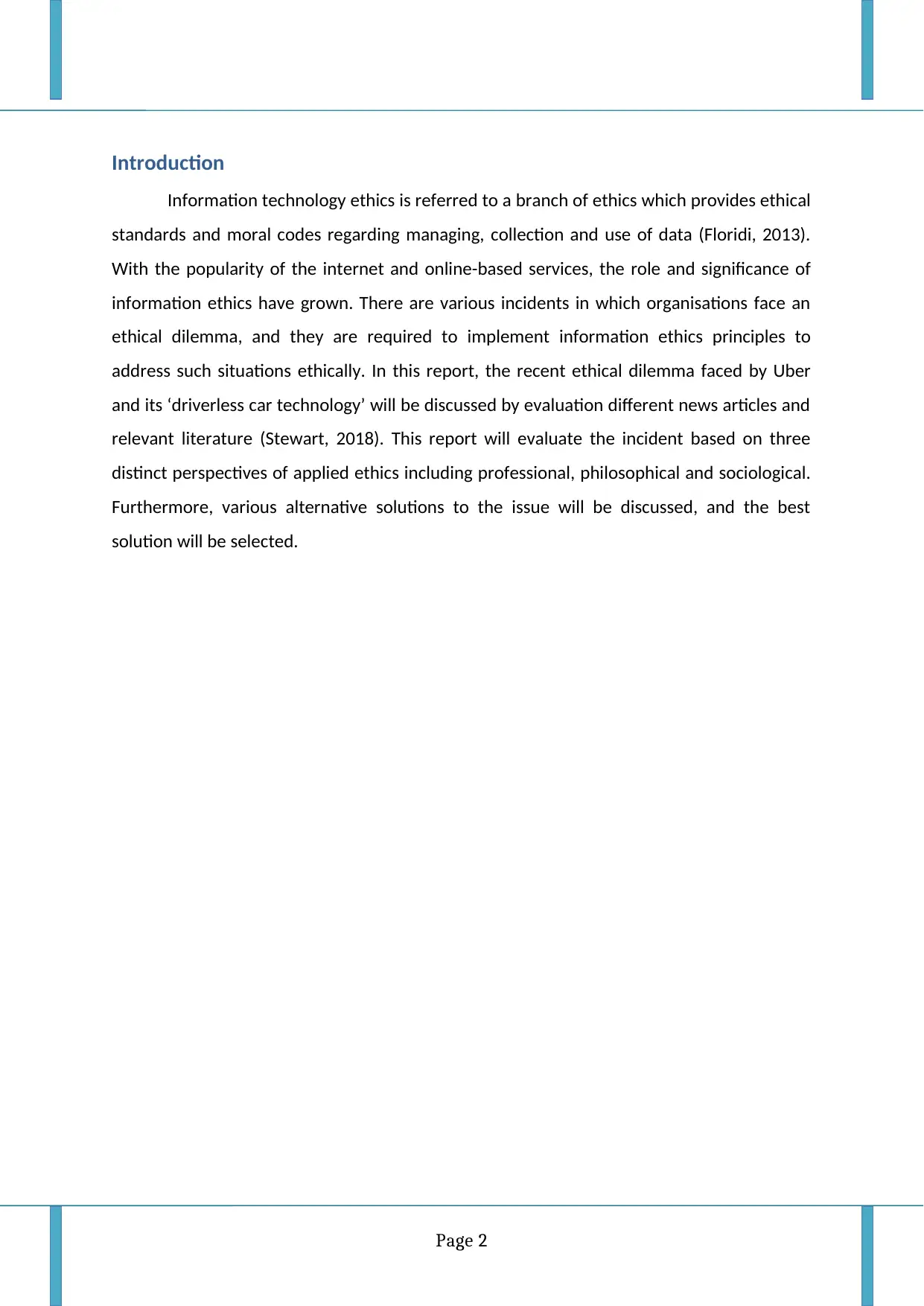
Introduction
Information technology ethics is referred to a branch of ethics which provides ethical
standards and moral codes regarding managing, collection and use of data (Floridi, 2013).
With the popularity of the internet and online-based services, the role and significance of
information ethics have grown. There are various incidents in which organisations face an
ethical dilemma, and they are required to implement information ethics principles to
address such situations ethically. In this report, the recent ethical dilemma faced by Uber
and its ‘driverless car technology’ will be discussed by evaluation different news articles and
relevant literature (Stewart, 2018). This report will evaluate the incident based on three
distinct perspectives of applied ethics including professional, philosophical and sociological.
Furthermore, various alternative solutions to the issue will be discussed, and the best
solution will be selected.
Page 2
Information technology ethics is referred to a branch of ethics which provides ethical
standards and moral codes regarding managing, collection and use of data (Floridi, 2013).
With the popularity of the internet and online-based services, the role and significance of
information ethics have grown. There are various incidents in which organisations face an
ethical dilemma, and they are required to implement information ethics principles to
address such situations ethically. In this report, the recent ethical dilemma faced by Uber
and its ‘driverless car technology’ will be discussed by evaluation different news articles and
relevant literature (Stewart, 2018). This report will evaluate the incident based on three
distinct perspectives of applied ethics including professional, philosophical and sociological.
Furthermore, various alternative solutions to the issue will be discussed, and the best
solution will be selected.
Page 2
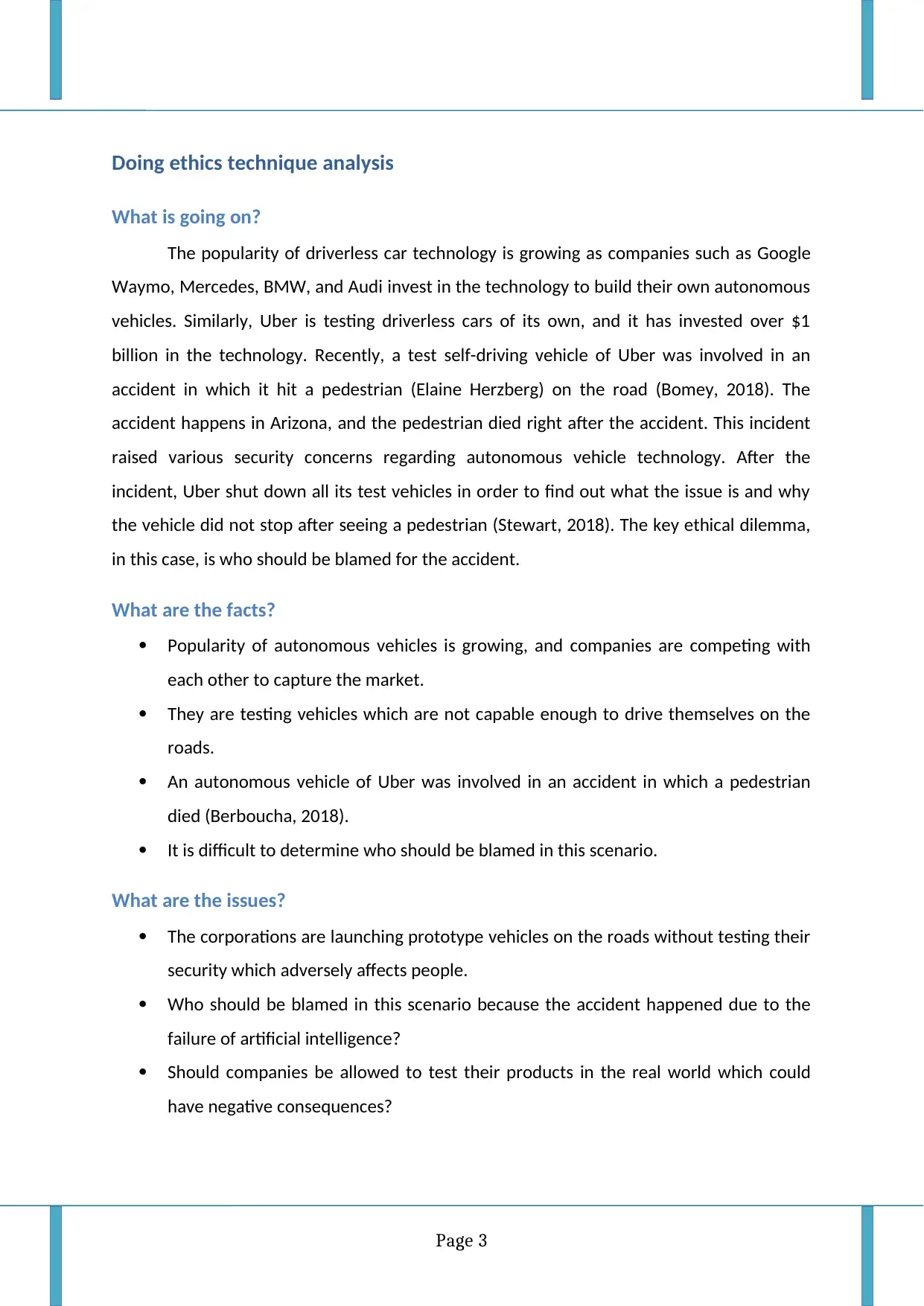
Doing ethics technique analysis
What is going on?
The popularity of driverless car technology is growing as companies such as Google
Waymo, Mercedes, BMW, and Audi invest in the technology to build their own autonomous
vehicles. Similarly, Uber is testing driverless cars of its own, and it has invested over $1
billion in the technology. Recently, a test self-driving vehicle of Uber was involved in an
accident in which it hit a pedestrian (Elaine Herzberg) on the road (Bomey, 2018). The
accident happens in Arizona, and the pedestrian died right after the accident. This incident
raised various security concerns regarding autonomous vehicle technology. After the
incident, Uber shut down all its test vehicles in order to find out what the issue is and why
the vehicle did not stop after seeing a pedestrian (Stewart, 2018). The key ethical dilemma,
in this case, is who should be blamed for the accident.
What are the facts?
Popularity of autonomous vehicles is growing, and companies are competing with
each other to capture the market.
They are testing vehicles which are not capable enough to drive themselves on the
roads.
An autonomous vehicle of Uber was involved in an accident in which a pedestrian
died (Berboucha, 2018).
It is difficult to determine who should be blamed in this scenario.
What are the issues?
The corporations are launching prototype vehicles on the roads without testing their
security which adversely affects people.
Who should be blamed in this scenario because the accident happened due to the
failure of artificial intelligence?
Should companies be allowed to test their products in the real world which could
have negative consequences?
Page 3
What is going on?
The popularity of driverless car technology is growing as companies such as Google
Waymo, Mercedes, BMW, and Audi invest in the technology to build their own autonomous
vehicles. Similarly, Uber is testing driverless cars of its own, and it has invested over $1
billion in the technology. Recently, a test self-driving vehicle of Uber was involved in an
accident in which it hit a pedestrian (Elaine Herzberg) on the road (Bomey, 2018). The
accident happens in Arizona, and the pedestrian died right after the accident. This incident
raised various security concerns regarding autonomous vehicle technology. After the
incident, Uber shut down all its test vehicles in order to find out what the issue is and why
the vehicle did not stop after seeing a pedestrian (Stewart, 2018). The key ethical dilemma,
in this case, is who should be blamed for the accident.
What are the facts?
Popularity of autonomous vehicles is growing, and companies are competing with
each other to capture the market.
They are testing vehicles which are not capable enough to drive themselves on the
roads.
An autonomous vehicle of Uber was involved in an accident in which a pedestrian
died (Berboucha, 2018).
It is difficult to determine who should be blamed in this scenario.
What are the issues?
The corporations are launching prototype vehicles on the roads without testing their
security which adversely affects people.
Who should be blamed in this scenario because the accident happened due to the
failure of artificial intelligence?
Should companies be allowed to test their products in the real world which could
have negative consequences?
Page 3
Secure Best Marks with AI Grader
Need help grading? Try our AI Grader for instant feedback on your assignments.
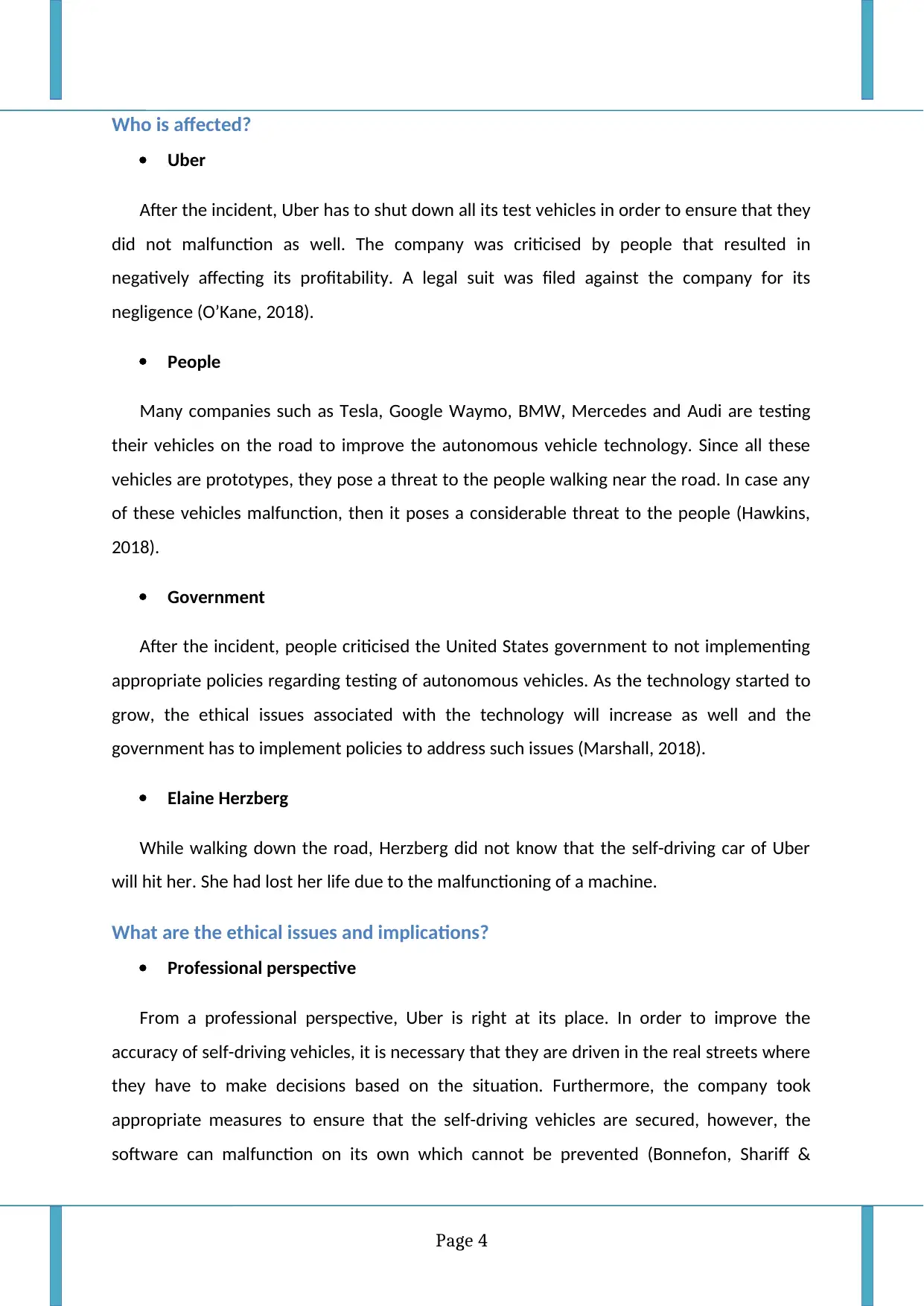
Who is affected?
Uber
After the incident, Uber has to shut down all its test vehicles in order to ensure that they
did not malfunction as well. The company was criticised by people that resulted in
negatively affecting its profitability. A legal suit was filed against the company for its
negligence (O’Kane, 2018).
People
Many companies such as Tesla, Google Waymo, BMW, Mercedes and Audi are testing
their vehicles on the road to improve the autonomous vehicle technology. Since all these
vehicles are prototypes, they pose a threat to the people walking near the road. In case any
of these vehicles malfunction, then it poses a considerable threat to the people (Hawkins,
2018).
Government
After the incident, people criticised the United States government to not implementing
appropriate policies regarding testing of autonomous vehicles. As the technology started to
grow, the ethical issues associated with the technology will increase as well and the
government has to implement policies to address such issues (Marshall, 2018).
Elaine Herzberg
While walking down the road, Herzberg did not know that the self-driving car of Uber
will hit her. She had lost her life due to the malfunctioning of a machine.
What are the ethical issues and implications?
Professional perspective
From a professional perspective, Uber is right at its place. In order to improve the
accuracy of self-driving vehicles, it is necessary that they are driven in the real streets where
they have to make decisions based on the situation. Furthermore, the company took
appropriate measures to ensure that the self-driving vehicles are secured, however, the
software can malfunction on its own which cannot be prevented (Bonnefon, Shariff &
Page 4
Uber
After the incident, Uber has to shut down all its test vehicles in order to ensure that they
did not malfunction as well. The company was criticised by people that resulted in
negatively affecting its profitability. A legal suit was filed against the company for its
negligence (O’Kane, 2018).
People
Many companies such as Tesla, Google Waymo, BMW, Mercedes and Audi are testing
their vehicles on the road to improve the autonomous vehicle technology. Since all these
vehicles are prototypes, they pose a threat to the people walking near the road. In case any
of these vehicles malfunction, then it poses a considerable threat to the people (Hawkins,
2018).
Government
After the incident, people criticised the United States government to not implementing
appropriate policies regarding testing of autonomous vehicles. As the technology started to
grow, the ethical issues associated with the technology will increase as well and the
government has to implement policies to address such issues (Marshall, 2018).
Elaine Herzberg
While walking down the road, Herzberg did not know that the self-driving car of Uber
will hit her. She had lost her life due to the malfunctioning of a machine.
What are the ethical issues and implications?
Professional perspective
From a professional perspective, Uber is right at its place. In order to improve the
accuracy of self-driving vehicles, it is necessary that they are driven in the real streets where
they have to make decisions based on the situation. Furthermore, the company took
appropriate measures to ensure that the self-driving vehicles are secured, however, the
software can malfunction on its own which cannot be prevented (Bonnefon, Shariff &
Page 4
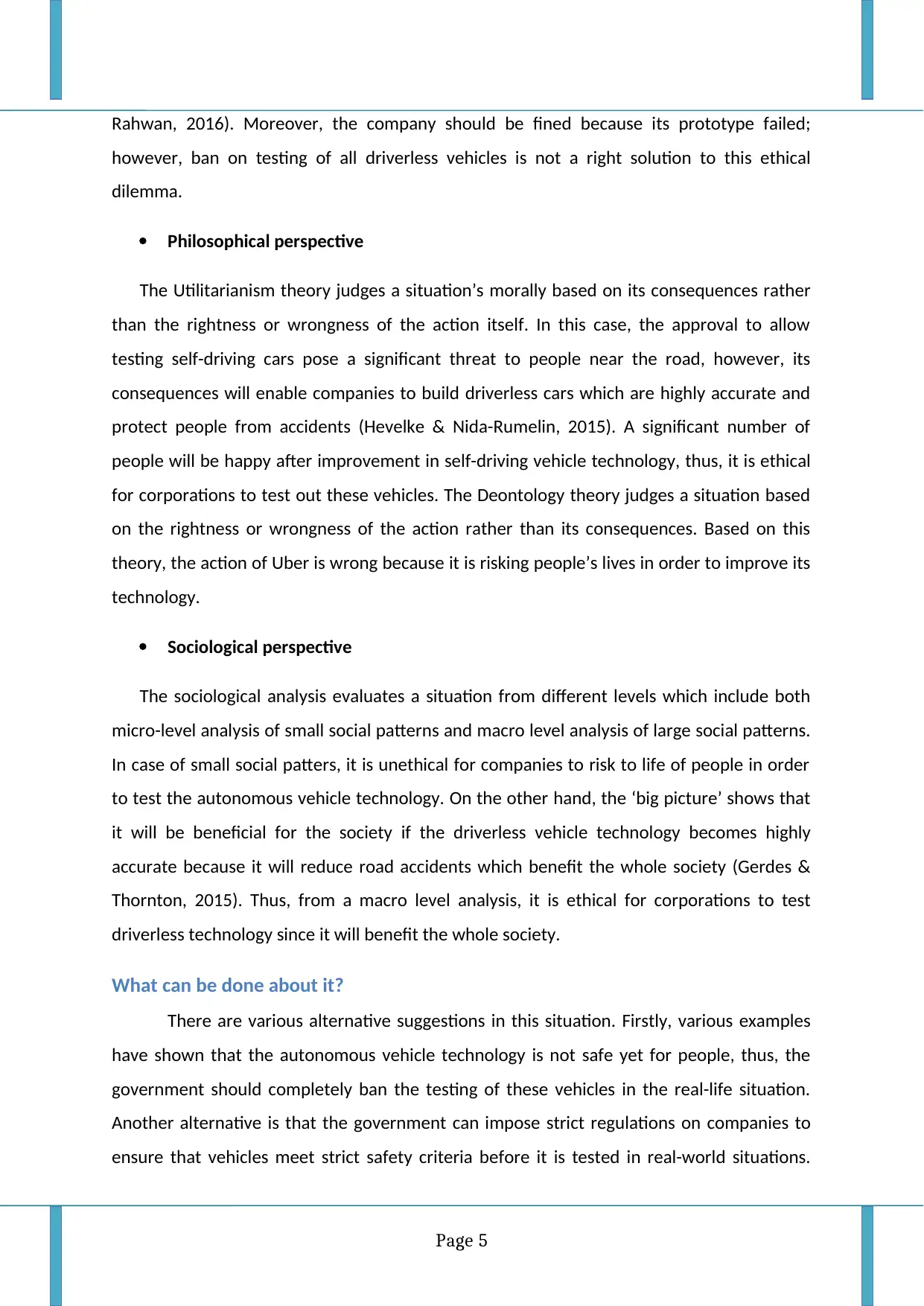
Rahwan, 2016). Moreover, the company should be fined because its prototype failed;
however, ban on testing of all driverless vehicles is not a right solution to this ethical
dilemma.
Philosophical perspective
The Utilitarianism theory judges a situation’s morally based on its consequences rather
than the rightness or wrongness of the action itself. In this case, the approval to allow
testing self-driving cars pose a significant threat to people near the road, however, its
consequences will enable companies to build driverless cars which are highly accurate and
protect people from accidents (Hevelke & Nida-Rumelin, 2015). A significant number of
people will be happy after improvement in self-driving vehicle technology, thus, it is ethical
for corporations to test out these vehicles. The Deontology theory judges a situation based
on the rightness or wrongness of the action rather than its consequences. Based on this
theory, the action of Uber is wrong because it is risking people’s lives in order to improve its
technology.
Sociological perspective
The sociological analysis evaluates a situation from different levels which include both
micro-level analysis of small social patterns and macro level analysis of large social patterns.
In case of small social patters, it is unethical for companies to risk to life of people in order
to test the autonomous vehicle technology. On the other hand, the ‘big picture’ shows that
it will be beneficial for the society if the driverless vehicle technology becomes highly
accurate because it will reduce road accidents which benefit the whole society (Gerdes &
Thornton, 2015). Thus, from a macro level analysis, it is ethical for corporations to test
driverless technology since it will benefit the whole society.
What can be done about it?
There are various alternative suggestions in this situation. Firstly, various examples
have shown that the autonomous vehicle technology is not safe yet for people, thus, the
government should completely ban the testing of these vehicles in the real-life situation.
Another alternative is that the government can impose strict regulations on companies to
ensure that vehicles meet strict safety criteria before it is tested in real-world situations.
Page 5
however, ban on testing of all driverless vehicles is not a right solution to this ethical
dilemma.
Philosophical perspective
The Utilitarianism theory judges a situation’s morally based on its consequences rather
than the rightness or wrongness of the action itself. In this case, the approval to allow
testing self-driving cars pose a significant threat to people near the road, however, its
consequences will enable companies to build driverless cars which are highly accurate and
protect people from accidents (Hevelke & Nida-Rumelin, 2015). A significant number of
people will be happy after improvement in self-driving vehicle technology, thus, it is ethical
for corporations to test out these vehicles. The Deontology theory judges a situation based
on the rightness or wrongness of the action rather than its consequences. Based on this
theory, the action of Uber is wrong because it is risking people’s lives in order to improve its
technology.
Sociological perspective
The sociological analysis evaluates a situation from different levels which include both
micro-level analysis of small social patterns and macro level analysis of large social patterns.
In case of small social patters, it is unethical for companies to risk to life of people in order
to test the autonomous vehicle technology. On the other hand, the ‘big picture’ shows that
it will be beneficial for the society if the driverless vehicle technology becomes highly
accurate because it will reduce road accidents which benefit the whole society (Gerdes &
Thornton, 2015). Thus, from a macro level analysis, it is ethical for corporations to test
driverless technology since it will benefit the whole society.
What can be done about it?
There are various alternative suggestions in this situation. Firstly, various examples
have shown that the autonomous vehicle technology is not safe yet for people, thus, the
government should completely ban the testing of these vehicles in the real-life situation.
Another alternative is that the government can impose strict regulations on companies to
ensure that vehicles meet strict safety criteria before it is tested in real-world situations.
Page 5
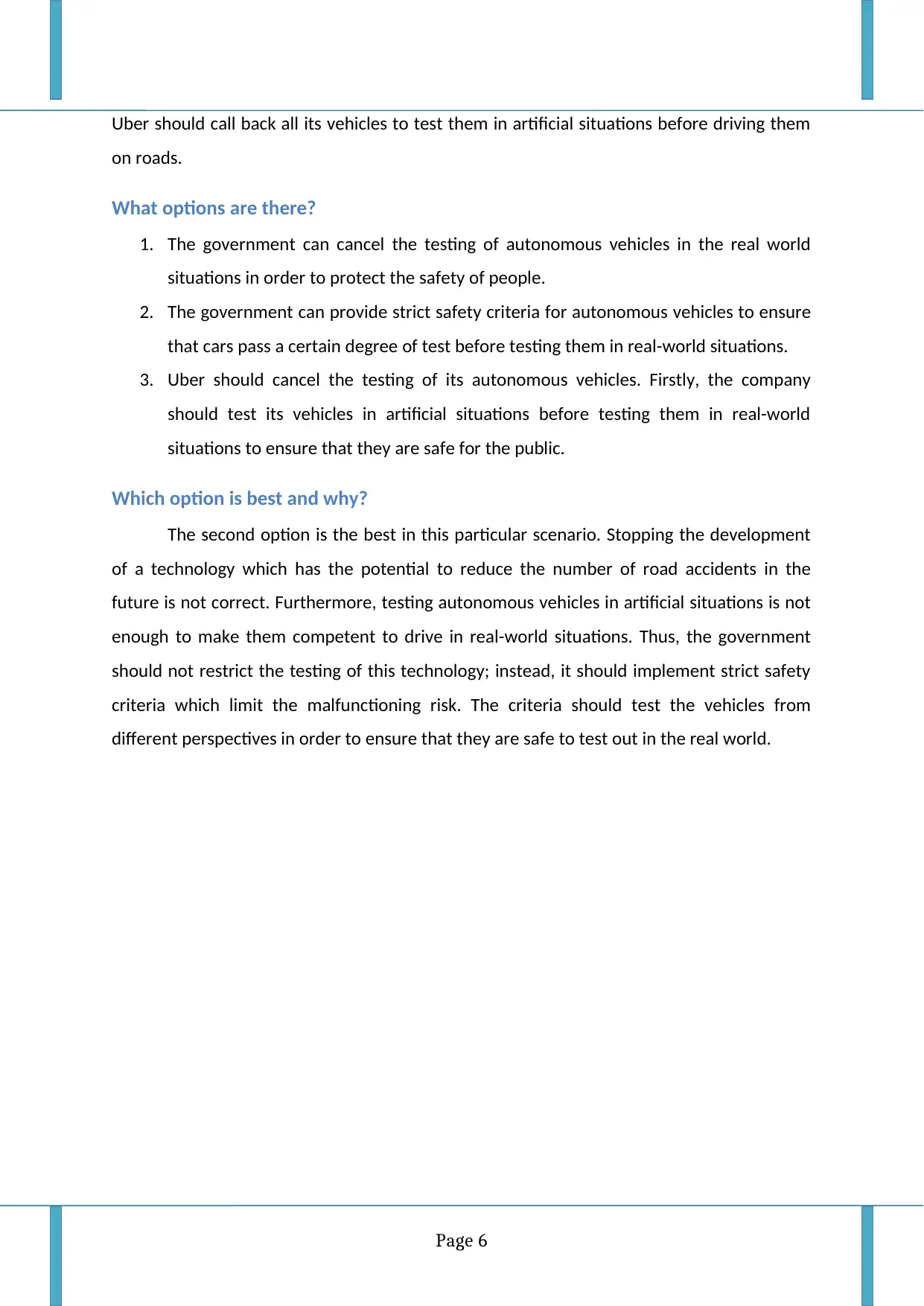
Uber should call back all its vehicles to test them in artificial situations before driving them
on roads.
What options are there?
1. The government can cancel the testing of autonomous vehicles in the real world
situations in order to protect the safety of people.
2. The government can provide strict safety criteria for autonomous vehicles to ensure
that cars pass a certain degree of test before testing them in real-world situations.
3. Uber should cancel the testing of its autonomous vehicles. Firstly, the company
should test its vehicles in artificial situations before testing them in real-world
situations to ensure that they are safe for the public.
Which option is best and why?
The second option is the best in this particular scenario. Stopping the development
of a technology which has the potential to reduce the number of road accidents in the
future is not correct. Furthermore, testing autonomous vehicles in artificial situations is not
enough to make them competent to drive in real-world situations. Thus, the government
should not restrict the testing of this technology; instead, it should implement strict safety
criteria which limit the malfunctioning risk. The criteria should test the vehicles from
different perspectives in order to ensure that they are safe to test out in the real world.
Page 6
on roads.
What options are there?
1. The government can cancel the testing of autonomous vehicles in the real world
situations in order to protect the safety of people.
2. The government can provide strict safety criteria for autonomous vehicles to ensure
that cars pass a certain degree of test before testing them in real-world situations.
3. Uber should cancel the testing of its autonomous vehicles. Firstly, the company
should test its vehicles in artificial situations before testing them in real-world
situations to ensure that they are safe for the public.
Which option is best and why?
The second option is the best in this particular scenario. Stopping the development
of a technology which has the potential to reduce the number of road accidents in the
future is not correct. Furthermore, testing autonomous vehicles in artificial situations is not
enough to make them competent to drive in real-world situations. Thus, the government
should not restrict the testing of this technology; instead, it should implement strict safety
criteria which limit the malfunctioning risk. The criteria should test the vehicles from
different perspectives in order to ensure that they are safe to test out in the real world.
Page 6
Paraphrase This Document
Need a fresh take? Get an instant paraphrase of this document with our AI Paraphraser
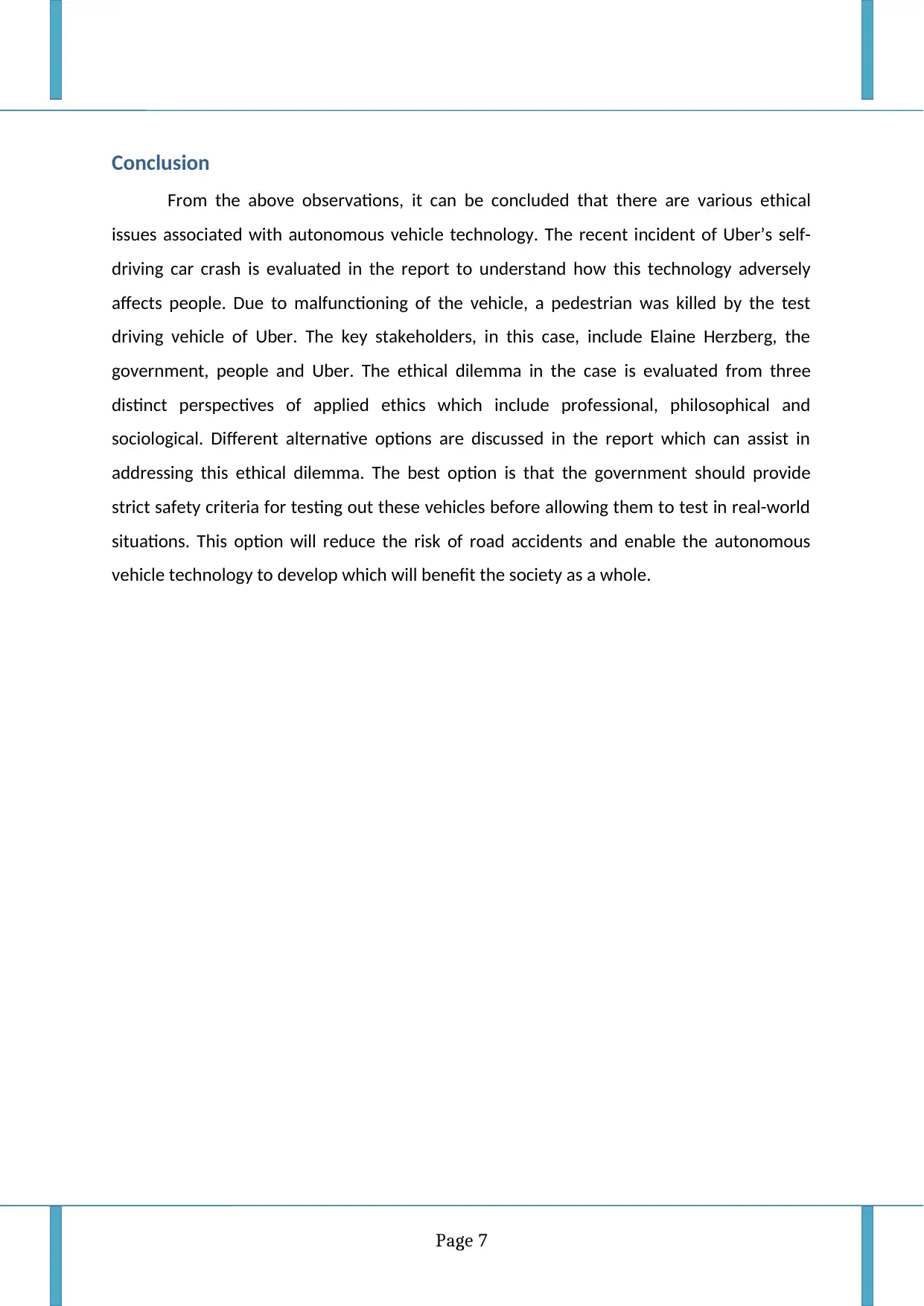
Conclusion
From the above observations, it can be concluded that there are various ethical
issues associated with autonomous vehicle technology. The recent incident of Uber’s self-
driving car crash is evaluated in the report to understand how this technology adversely
affects people. Due to malfunctioning of the vehicle, a pedestrian was killed by the test
driving vehicle of Uber. The key stakeholders, in this case, include Elaine Herzberg, the
government, people and Uber. The ethical dilemma in the case is evaluated from three
distinct perspectives of applied ethics which include professional, philosophical and
sociological. Different alternative options are discussed in the report which can assist in
addressing this ethical dilemma. The best option is that the government should provide
strict safety criteria for testing out these vehicles before allowing them to test in real-world
situations. This option will reduce the risk of road accidents and enable the autonomous
vehicle technology to develop which will benefit the society as a whole.
Page 7
From the above observations, it can be concluded that there are various ethical
issues associated with autonomous vehicle technology. The recent incident of Uber’s self-
driving car crash is evaluated in the report to understand how this technology adversely
affects people. Due to malfunctioning of the vehicle, a pedestrian was killed by the test
driving vehicle of Uber. The key stakeholders, in this case, include Elaine Herzberg, the
government, people and Uber. The ethical dilemma in the case is evaluated from three
distinct perspectives of applied ethics which include professional, philosophical and
sociological. Different alternative options are discussed in the report which can assist in
addressing this ethical dilemma. The best option is that the government should provide
strict safety criteria for testing out these vehicles before allowing them to test in real-world
situations. This option will reduce the risk of road accidents and enable the autonomous
vehicle technology to develop which will benefit the society as a whole.
Page 7
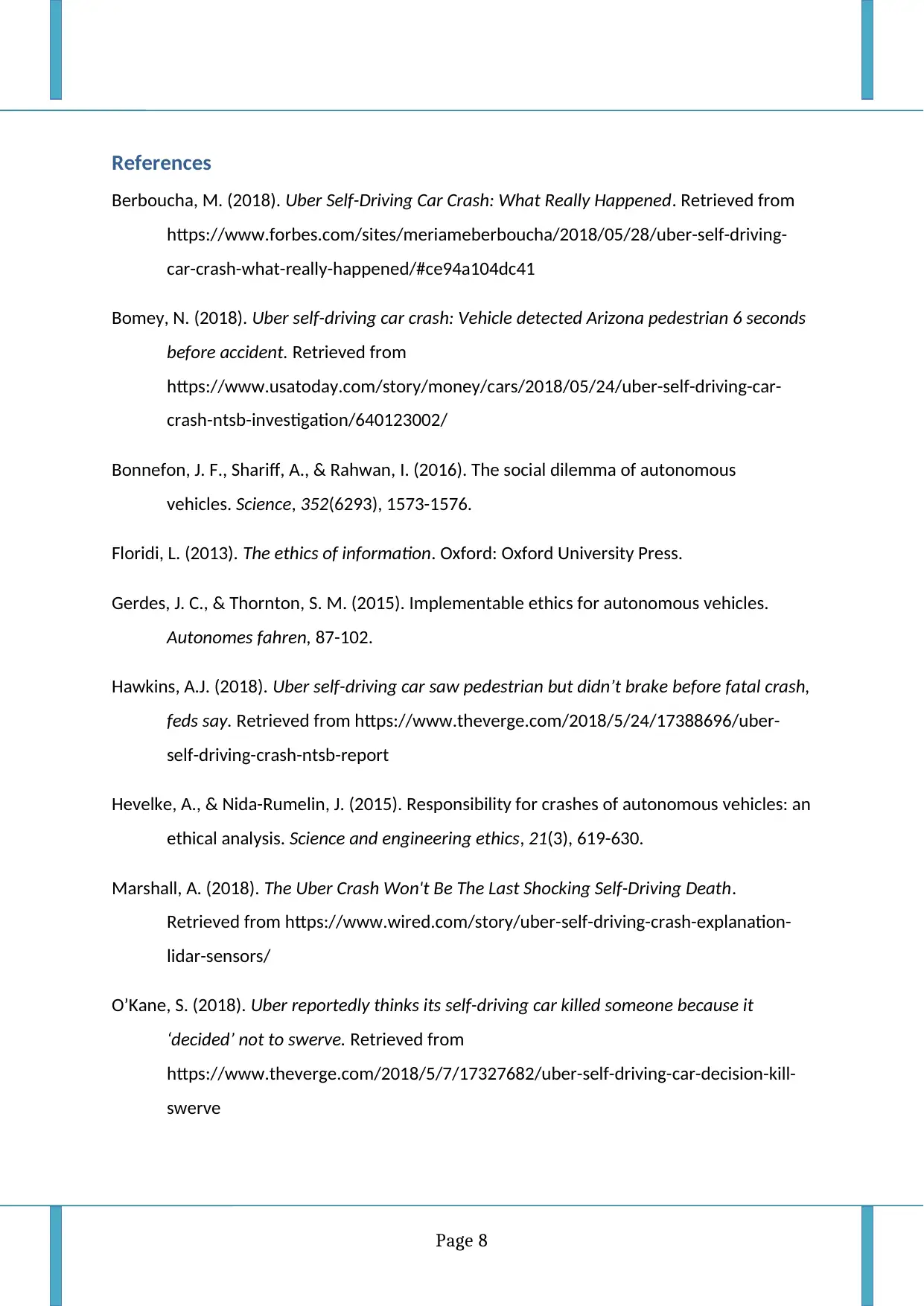
References
Berboucha, M. (2018). Uber Self-Driving Car Crash: What Really Happened. Retrieved from
https://www.forbes.com/sites/meriameberboucha/2018/05/28/uber-self-driving-
car-crash-what-really-happened/#ce94a104dc41
Bomey, N. (2018). Uber self-driving car crash: Vehicle detected Arizona pedestrian 6 seconds
before accident. Retrieved from
https://www.usatoday.com/story/money/cars/2018/05/24/uber-self-driving-car-
crash-ntsb-investigation/640123002/
Bonnefon, J. F., Shariff, A., & Rahwan, I. (2016). The social dilemma of autonomous
vehicles. Science, 352(6293), 1573-1576.
Floridi, L. (2013). The ethics of information. Oxford: Oxford University Press.
Gerdes, J. C., & Thornton, S. M. (2015). Implementable ethics for autonomous vehicles.
Autonomes fahren, 87-102.
Hawkins, A.J. (2018). Uber self-driving car saw pedestrian but didn’t brake before fatal crash,
feds say. Retrieved from https://www.theverge.com/2018/5/24/17388696/uber-
self-driving-crash-ntsb-report
Hevelke, A., & Nida-Rumelin, J. (2015). Responsibility for crashes of autonomous vehicles: an
ethical analysis. Science and engineering ethics, 21(3), 619-630.
Marshall, A. (2018). The Uber Crash Won't Be The Last Shocking Self-Driving Death.
Retrieved from https://www.wired.com/story/uber-self-driving-crash-explanation-
lidar-sensors/
O’Kane, S. (2018). Uber reportedly thinks its self-driving car killed someone because it
‘decided’ not to swerve. Retrieved from
https://www.theverge.com/2018/5/7/17327682/uber-self-driving-car-decision-kill-
swerve
Page 8
Berboucha, M. (2018). Uber Self-Driving Car Crash: What Really Happened. Retrieved from
https://www.forbes.com/sites/meriameberboucha/2018/05/28/uber-self-driving-
car-crash-what-really-happened/#ce94a104dc41
Bomey, N. (2018). Uber self-driving car crash: Vehicle detected Arizona pedestrian 6 seconds
before accident. Retrieved from
https://www.usatoday.com/story/money/cars/2018/05/24/uber-self-driving-car-
crash-ntsb-investigation/640123002/
Bonnefon, J. F., Shariff, A., & Rahwan, I. (2016). The social dilemma of autonomous
vehicles. Science, 352(6293), 1573-1576.
Floridi, L. (2013). The ethics of information. Oxford: Oxford University Press.
Gerdes, J. C., & Thornton, S. M. (2015). Implementable ethics for autonomous vehicles.
Autonomes fahren, 87-102.
Hawkins, A.J. (2018). Uber self-driving car saw pedestrian but didn’t brake before fatal crash,
feds say. Retrieved from https://www.theverge.com/2018/5/24/17388696/uber-
self-driving-crash-ntsb-report
Hevelke, A., & Nida-Rumelin, J. (2015). Responsibility for crashes of autonomous vehicles: an
ethical analysis. Science and engineering ethics, 21(3), 619-630.
Marshall, A. (2018). The Uber Crash Won't Be The Last Shocking Self-Driving Death.
Retrieved from https://www.wired.com/story/uber-self-driving-crash-explanation-
lidar-sensors/
O’Kane, S. (2018). Uber reportedly thinks its self-driving car killed someone because it
‘decided’ not to swerve. Retrieved from
https://www.theverge.com/2018/5/7/17327682/uber-self-driving-car-decision-kill-
swerve
Page 8
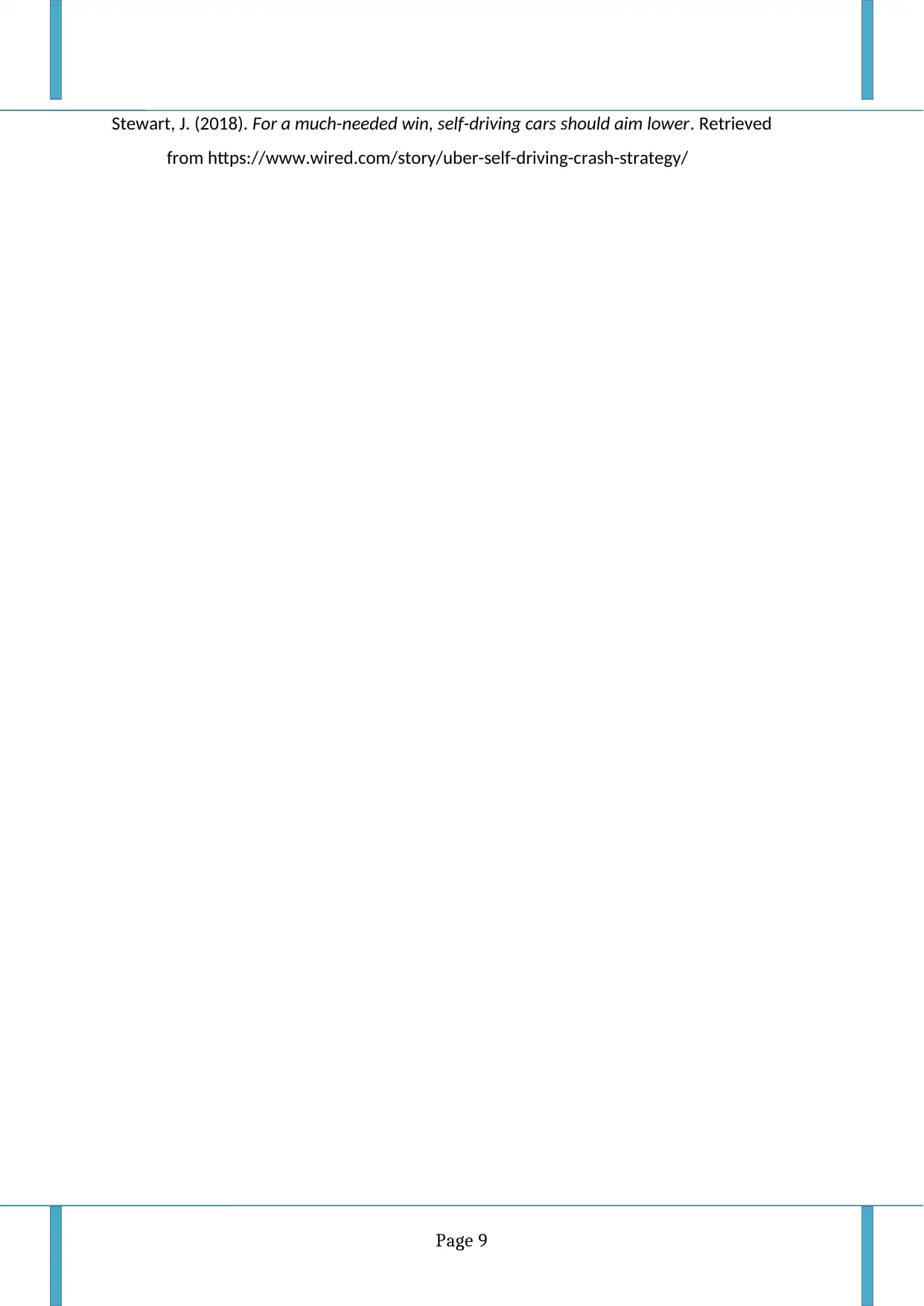
Stewart, J. (2018). For a much-needed win, self-driving cars should aim lower. Retrieved
from https://www.wired.com/story/uber-self-driving-crash-strategy/
Page 9
from https://www.wired.com/story/uber-self-driving-crash-strategy/
Page 9
1 out of 10
Related Documents
Your All-in-One AI-Powered Toolkit for Academic Success.
+13062052269
info@desklib.com
Available 24*7 on WhatsApp / Email
![[object Object]](/_next/static/media/star-bottom.7253800d.svg)
Unlock your academic potential
© 2024 | Zucol Services PVT LTD | All rights reserved.





